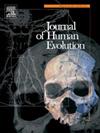The effects of carnivore diversity on scavenging opportunities and hominin range expansion during Out of Africa I
IF 3.1
1区 地球科学
Q1 ANTHROPOLOGY
引用次数: 0
Abstract
Numerous extrinsic hypotheses explaining Out of Africa I (OoA I), like faunal turnover and hominins following fauna, have been rejected based on paleoecological models. Others have explored the importance of the hominin intrusion into the carnivore guild. Here, I build on this latter research by proposing the complementary carnivore guild flexibility hypothesis (CGFH). In eastern Africa, carnivore richness peaked around 3 Ma and declined gradually until shortly after 2 Ma. This timeline coincides with the development of early lithic technologies and initial evidence of the butchery of large mammals, thus implying that increased hominin carnivory impacted endemic carnivore diversity through the transition from passive to confrontational scavenging. The CGFH posits that the relatively stable carnivore diversity and richness in Eurasia permitted hominin range expansion into Eurasian habitats after 2 Ma due to scavenging opportunities along continuously overlapping carnivore ranges. This study tests the CGFH by examining carnivore richness at African and Eurasian sites covering intervals before, during, and after the initial OoA I dispersals. This study builds on previous hypotheses about the role of carnivore guilds in hominin dispersals while tying in theoretical models on modes of early hominin carnivory and actualistic research on scavenging opportunities resulting from carnivore guild composition. In support of the CGFH, carnivore richness in Eurasia is higher than in Africa, which likely facilitated range expansion by hominins during OoA I. Furthermore, decreases in carnivore richness are evident in Eurasia at the end of the Early Pleistocene, which happen within a few hundred thousand years of sustained hominin presence in certain regions, like southwestern Europe and eastern Asia.
“走出非洲”时期食肉动物多样性对食腐机会和人类活动范围扩大的影响
许多解释“走出非洲I”(OoA I)的外在假设,如动物更替和人族追随动物,都被古生态学模型所拒绝。其他人则探索了人类入侵食肉动物行会的重要性。在此,我以后一项研究为基础,提出了互补食肉动物行会灵活性假说(CGFH)。在非洲东部,食肉动物丰富度在3 Ma左右达到顶峰,并逐渐下降,直到2 Ma之后不久。这个时间线与早期石器技术的发展和屠杀大型哺乳动物的初步证据相吻合,这意味着人类食肉动物的增加通过从被动到对抗性食腐的转变影响了地方性食肉动物的多样性。CGFH认为欧亚大陆相对稳定的食肉动物多样性和丰富度允许人类在2 Ma之后扩展到欧亚大陆的栖息地,这是由于沿着不断重叠的食肉动物范围的食腐机会。本研究通过研究非洲和欧亚地区的食肉动物丰富度来测试CGFH,这些地点覆盖了最初的OoA I扩散之前、期间和之后的时间间隔。本研究建立在先前关于食肉动物行会在人类迁徙中所起作用的假设的基础上,同时结合了早期人类食肉动物模式的理论模型和食肉动物行会构成导致的食腐机会的实际研究。为了支持CGFH,欧亚大陆的食肉动物丰富度高于非洲,这可能促进了古人类在OoA i期间的范围扩张。此外,早更新世末期欧亚大陆的食肉动物丰富度明显下降,这发生在某些地区,如欧洲西南部和东亚,人类持续存在的几十万年之内。
本文章由计算机程序翻译,如有差异,请以英文原文为准。
求助全文
约1分钟内获得全文
求助全文
来源期刊

Journal of Human Evolution
生物-进化生物学
CiteScore
6.30
自引率
15.60%
发文量
104
审稿时长
3 months
期刊介绍:
The Journal of Human Evolution concentrates on publishing the highest quality papers covering all aspects of human evolution. The central focus is aimed jointly at paleoanthropological work, covering human and primate fossils, and at comparative studies of living species, including both morphological and molecular evidence. These include descriptions of new discoveries, interpretative analyses of new and previously described material, and assessments of the phylogeny and paleobiology of primate species. Submissions should address issues and questions of broad interest in paleoanthropology.
 求助内容:
求助内容: 应助结果提醒方式:
应助结果提醒方式:


